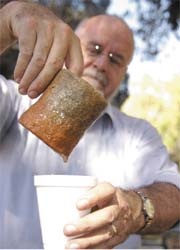Filter promises clean water for millions
Lack of clean water causes as well as perpetuates diseases. Nonetheless, filtration systems have remained beyond the budgets of those most threatened by waterborne pathogens - until now.

Despite the apparent simplicity of filters he devised from these, with David Goggin, an engineering undergraduate studying ceramics, the science involved was not simple. Pathogens are very small, so a filter’s pore size must be smaller than them. Time and again samples of different combinations were mixed, fired and tested for strength and filtering ability. Clay composition, plus the size of holes left by burned out organic material would be critical, as would their distribution across the fired material. ‘You can have a clay that is very, very porous but the pores might be sealed and not connected to each other. What’s very desirable is that the void fraction is articulated or joined. You can have a structure that has a very fine void cross section through which water will seep very slowly, but if you want to produce the volume of water that a family of four, five or more might consume during a day, you’d have to look at something that would be capable of working reliably and continuously with a flow rate of perhaps 8-10 litres over, say, 16 hours.’
The area’s clay had a very narrow particle size range, which meant a lot of shrinkage and a very fine articulated porosity fraction within the structure, so filtering was very slow and it would block quickly. A mix of that clay with coarser clay was tested. In addition, beach sand was found to introduce salt that caused too much shrinkage in the filters. River sand proved a better option.
THE RECIPE
Shopping list
Organic materials e.g. tea leaves, coffee grounds, rice husks, clay, straw, manure.
Method
To a handful of crushed clay add a handful of organic material and mix with enough water to form a stiff, biscuit-like texture. Shape this into a cylindrical pot, with one end closed, and dry in the sun.
Baking oven and time
Pack straw around the cylinder and place it within in a mound of cow dung. Light the straw. Top up the burning manure as needed. The filter will be baked in under 60 minutes.
During the firing, the organic materials burn away, leaving tiny ‘pores’ in the clay in which pathogens become trapped when water passes through the filter. In tests, the ceramic filters removed 96.4 - 99.8% of E-coli bacterium - well within safe levels - and the filter cleanses a litre of water in about two hours.
‘A potter’s kiln is an expensive item and could take up to four or five hours to heat. It needs expensive or scarce fuel, such as gas or wood, to heat it, as well as experience to run it,’ Tony Flynn reasoned. ‘With no technology, and no insulation, none of these restrictions apply. The filters are very simple to explain and demonstrate and can be made by anyone, anywhere. They don’t require any Western technology. All you need is terracotta clay, a compliant cow and a match.’
01.03.2005





